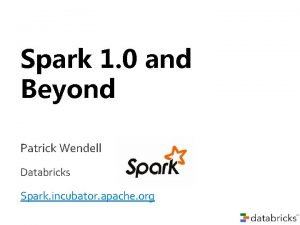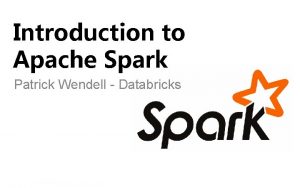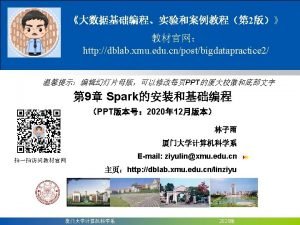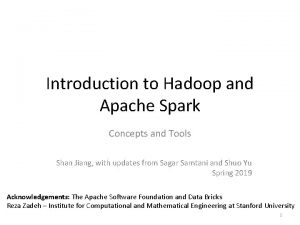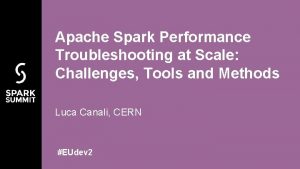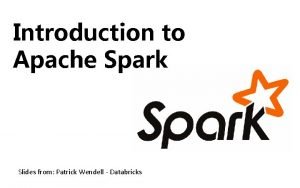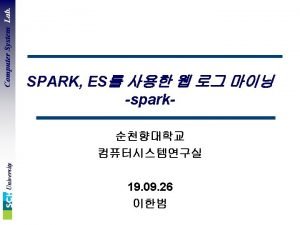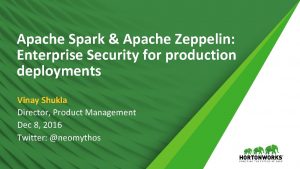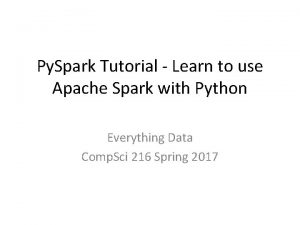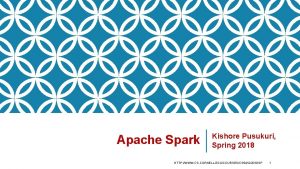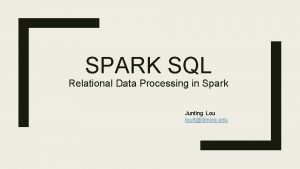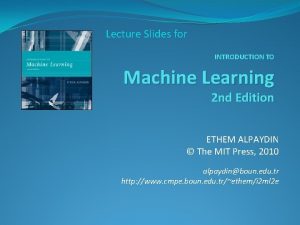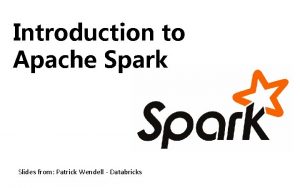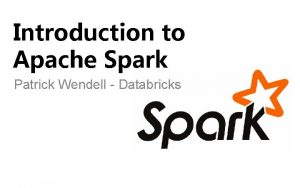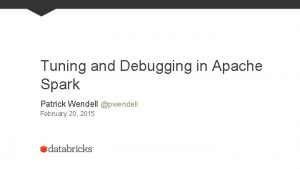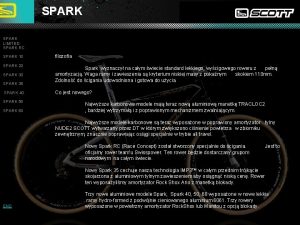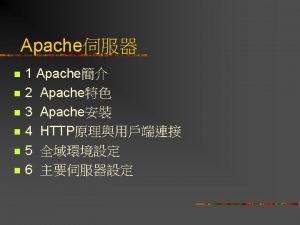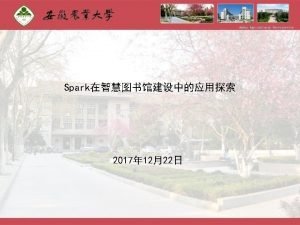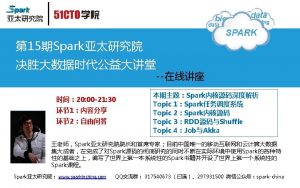Introduction to Apache Spark Slides from Patrick Wendell










![Basic Transformations > nums = sc. parallelize([1, 2, 3]) # Pass each element through Basic Transformations > nums = sc. parallelize([1, 2, 3]) # Pass each element through](https://slidetodoc.com/presentation_image_h/27fa23a1957457505bf71847cd924388/image-11.jpg)
![Basic Actions > nums = sc. parallelize([1, 2, 3]) # Retrieve RDD contents as Basic Actions > nums = sc. parallelize([1, 2, 3]) # Retrieve RDD contents as](https://slidetodoc.com/presentation_image_h/27fa23a1957457505bf71847cd924388/image-12.jpg)

![Some Key-Value Operations > pets = sc. parallelize( [(“cat”, 1), (“dog”, 1), (“cat”, 2)]) Some Key-Value Operations > pets = sc. parallelize( [(“cat”, 1), (“dog”, 1), (“cat”, 2)])](https://slidetodoc.com/presentation_image_h/27fa23a1957457505bf71847cd924388/image-14.jpg)











- Slides: 25

Introduction to Apache Spark Slides from: Patrick Wendell - Databricks

What is Spark? Fast and Expressive Cluster Computing Engine Compatible with Apache Hadoop 10× faster o 100× in m n disk, 2 -5× less emory code Efficient Usable Up to • General execution graphs • In-memory storage • Rich APIs in Java, Scala, Python • Interactive shell

Spark Programming Model

Key Concept: RDD’s Write programs in terms of operations on distributed datasets Resilient Distributed Datasets • Collections of objects spread across a cluster, stored in RAM or on Disk • Built through parallel transformations Operations • Transformations (e. g. map, filter, group. By) • Actions (e. g. count, collect, save)

Example: Log Mining Load error messages from a log into memory, then interactively search for various patterns Base RDD Transformed RDD Cache 1 lines = spark. text. File(“hdfs: //. . . ”) results errors = lines. filter(lambda s: s. startswith(“ERROR”)) messages = errors. map(lambda s: s. split(“t”)[2]) Driver tasks Worker Block 1 messages. cache() messages. filter(lambda s: “mysql” in s). count() Action Worker messages. filter(lambda s: “php” in s). count(). . . Cache 3 Full-text search of Wikipedia • 60 GB on 20 EC 2 machine • 0. 5 sec vs. 20 s for on-disk Cache 2 Worker Block 3 Block 2

12 30 41 58 100 80 60 40 20 0 69 Execution time (s) Impact of Caching on Performance Cache disabled 25% 50% 75% % of working set in cache Fully cached

Fault Recovery RDDs track lineage information that can be used to efficiently recompute lost data msgs = text. File. filter(lambda s: s. starts. With(“ERROR”)). map(lambda s: s. split(“t”)[2]) HDFS File Filtered RDD filter (func = starts. With(…)) Mapped RDD map (func = split(. . . ))

Programming with RDD’s

Spark. Context • Main entry point to Spark functionality • Available in shell as variable sc • In standalone programs, you’d make your own

Creating RDDs # Turn a Python collection into an RDD > sc. parallelize([1, 2, 3]) # > > > Load text file from local FS, HDFS, or S 3 sc. text. File(“file. txt”) sc. text. File(“directory/*. txt”) sc. text. File(“hdfs: //namenode: 9000/path/file”)
![Basic Transformations nums sc parallelize1 2 3 Pass each element through Basic Transformations > nums = sc. parallelize([1, 2, 3]) # Pass each element through](https://slidetodoc.com/presentation_image_h/27fa23a1957457505bf71847cd924388/image-11.jpg)
Basic Transformations > nums = sc. parallelize([1, 2, 3]) # Pass each element through a function > squares = nums. map(lambda x: x*x) // {1, 4, 9} # Keep elements passing a predicate > even = squares. filter(lambda x: x % 2 == 0) // {4} # Map each element to zero or more others > nums. flat. Map(lambda x: => range(x)) > # => {0, 0, 1, 2} Range object (sequence of numbers 0, 1, …, x-1)
![Basic Actions nums sc parallelize1 2 3 Retrieve RDD contents as Basic Actions > nums = sc. parallelize([1, 2, 3]) # Retrieve RDD contents as](https://slidetodoc.com/presentation_image_h/27fa23a1957457505bf71847cd924388/image-12.jpg)
Basic Actions > nums = sc. parallelize([1, 2, 3]) # Retrieve RDD contents as a local collection > nums. collect() # => [1, 2, 3] # Return first K elements > nums. take(2) # => [1, 2] # Count number of elements > nums. count() # => 3 # Merge elements with an associative function > nums. reduce(lambda x, y: x + y) # => 6 # Write elements to a text file > nums. save. As. Text. File(“hdfs: //file. txt”)

Working with Key-Value Pairs Spark’s “distributed reduce” transformations operate on RDDs of key-value pairs Python: pair = (a, b) pair[0] # => a pair[1] # => b Scala: val pair = (a, b) pair. _1 // => a pair. _2 // => b Java: Tuple 2 pair = new Tuple 2(a, b); pair. _1 // => a pair. _2 // => b
![Some KeyValue Operations pets sc parallelize cat 1 dog 1 cat 2 Some Key-Value Operations > pets = sc. parallelize( [(“cat”, 1), (“dog”, 1), (“cat”, 2)])](https://slidetodoc.com/presentation_image_h/27fa23a1957457505bf71847cd924388/image-14.jpg)
Some Key-Value Operations > pets = sc. parallelize( [(“cat”, 1), (“dog”, 1), (“cat”, 2)]) > pets. reduce. By. Key(lambda x, y: x + y) # => {(cat, 3), (dog, 1)} > pets. group. By. Key() # => {(cat, [1, 2]), (dog, [1])} > pets. sort. By. Key() # => {(cat, 1), (cat, 2), (dog, 1)}

Word Count (Python) > lines = sc. text. File(“hamlet. txt”) > counts = lines. flat. Map(lambda line: line. split(“ ”)). map(lambda word => (word, 1)). reduce. By. Key(lambda x, y: x + y). save. As. Text. File(“results”) “to be or” “not to be” “to” “be” “or” “not” “to” “be” (to, 1) (be, 1) (or, 1) (not, 1) (to, 1) (be, 2) (not, 1) (or, 1) (to, 2)

Word Count (Scala) val text. File = sc. text. File(“hamlet. txt”) text. File. flat. Map(line => tokenize(line)). map(word => (word, 1)). reduce. By. Key((x, y) => x + y). save. As. Text. File(“results”)

Word Count (Java) val text. File = sc. text. File(“hamlet. txt”) text. File. map(object mapper { def map(key: Long, value: Text) = tokenize(value). foreach(word => write(word, 1)) }). reduce(object reducer { def reduce(key: Text, values: Iterable[Int]) = { var sum = 0 for (value <- values) sum += value write(key, sum) }). save. As. Text. File(“results)

Other Key-Value Operations > visits = sc. parallelize([ (“index. html”, “ 1. 2. 3. 4”), (“about. html”, “ 3. 4. 5. 6”), (“index. html”, “ 1. 3. 3. 1”) ]) > page. Names = sc. parallelize([ (“index. html”, “Home”), (“about. html”, “About”) ]) > visits. join(page. Names) # (“index. html”, (“ 1. 2. 3. 4”, “Home”)) # (“index. html”, (“ 1. 3. 3. 1”, “Home”)) # (“about. html”, (“ 3. 4. 5. 6”, “About”)) > visits. cogroup(page. Names) # (“index. html”, ([“ 1. 2. 3. 4”, “ 1. 3. 3. 1”], [“Home”])) # (“about. html”, ([“ 3. 4. 5. 6”], [“About”]))

Setting the Level of Parallelism All the pair RDD operations take an optional second parameter for number of tasks > words. reduce. By. Key(lambda x, y: x + y, 5) > words. group. By. Key(5) > visits. join(page. Views, 5)

Under The Hood: DAG Scheduler • General task graphs • Automatically pipelines functions • Data locality aware • Partitioning aware to avoid shuffles B: A: Stage 1 C: F: group. By D: E: join Stage 2 map = RDD filter = cached partition Stage 3

Physical Operators

More RDD Operators • map • reduce • filter • count • group. By • fold • sort • reduce. By. Key • union • group. By. Key partition. By • join • cogroup map. With • left. Outer. Join • cross pipe • right. Outer. Join • zip sample take first save . . .

PERFORMANCE

Hadoop Spark 100 50 0 14 80 150 23 Iteration time (s) 200 171 Page. Rank Performance 30 60 Number of machines

Other Iterative Algorithms 155 K-Means Clustering Hadoop 4. 1 0 Spark 30 60 90 120 150 180 110 Logistic Regression 0. 96 0 25 50 75 100 Time per Iteration (s) 125
 Degree of financial leverage formula
Degree of financial leverage formula Patrick wendell databricks
Patrick wendell databricks Kay ousterhout
Kay ousterhout 45000-16000
45000-16000 Rdd
Rdd Introduction to apache spark
Introduction to apache spark Apache spark concepts
Apache spark concepts Apache spark challenges
Apache spark challenges Sentiment analysis (with spark)
Sentiment analysis (with spark) Apache spark presentation
Apache spark presentation Zeppelin university
Zeppelin university Apache spark security
Apache spark security Spark tutorial
Spark tutorial Spark context
Spark context Apache spark vs spring
Apache spark vs spring Spark sql: relational data processing in spark
Spark sql: relational data processing in spark Wendell p bloyd
Wendell p bloyd Wendell
Wendell Oliver wendell holmes star spangled banner
Oliver wendell holmes star spangled banner Kay ousterhout
Kay ousterhout Wendell ocasio
Wendell ocasio A small child slides down the four frictionless slides
A small child slides down the four frictionless slides Force and work relationship quick check
Force and work relationship quick check Patrick: an introduction to medicinal chemistry 3e
Patrick: an introduction to medicinal chemistry 3e Machine learning course slides
Machine learning course slides Introduction to machine learning slides
Introduction to machine learning slides



